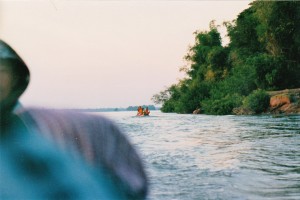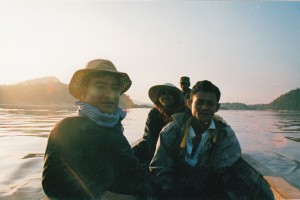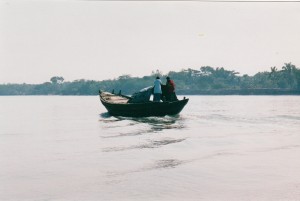[In January 2003 I accompanied an expedition that was conducting a survey of river dolphins on a stretch of the Mekong River in Cambodia. The expedition was led by Isabel Beasley, who was then a PhD student specializing on Orcaella brevirostris: also known as the ‘Irrawaddy Dolphin’ this species is found in many Asian river systems and deltas. The journal I kept during the expedition will appear on this site as a continuous series of posts. This is part 16 of the series.]
The whole point of the survey is to create very highly standardized measurements and recordings. In ‘On Effort’ periods, in Isabel’s survey, there are 2 observers on duty for 30 minutes, One is in the prow of the boat, looking through binoculars, covering a 180 degree view. The other observer in the meanwhile, is observing with the naked eye and he/she sits aft. The observers are both usually seated, although they can stand if they want to. The observers change position with other observers every 30 minutes, working in groups of two.
Isabel says that is she had a different kind of boat she would have liked to have an observer in the stern as well. This is a lesson learnt from surveys of the Inya – the Amazon dolphin – which tends to sound at the approach of a boat and surfaces well behind (and are thus often missed). Also one observer at the stern of the boat also provides some sense of the number of animals being missed by the others.
Observers who are On Duty are called Primary Observers and those who’re off-duty are called Independent Observers. If observers who are resting make a sighting that has been missed by the Primary Observers, then those have to be attributed to the Independent Observers.
In a large boat, with more personnel, Isabel would have arranged the observers differently. There would be three observers in the bows, one looking left, one right and one directly ahead. The left and right observers would be armed with binoculars, while the forward looking observer would be watching with the naked eye.
 The speed of the boat is ideally between 8 to 10 kmph.
The speed of the boat is ideally between 8 to 10 kmph.
The effort sheet also records many other things: the direction of travel, depth, turbidity, habitat-type, state of the river etc. All these are recorded every time there is a change of observer – in other words ever 30 minutes. If a dolphin should happen to be sighted, that results in an E.E. – ‘End of Effort’. After that a data sheet has to be filled in, recording the details of the sighting.
These protocols, as Isabel uses them, are based largely on the methodologies that she learnt while working on coastal surveys in Hong Kong. But they also draw on a paper on surveying methodology for river dolphins that was published in 2000 by two Australian cetologists.
The recording of the boats’ track is done only while On-Effort. After a spotting the GPS is switched off and is turned on again only when the effort resumes. Turbidity is recorded through Secchi Disk readings. This is a marked disk that is dipped in the water. The point at which the markings cannot be read is the measure of the turbidity. Water temperature is recorded with a simple thermometer, of the kind used in domestic aquariums.
One of the useful tools is a software package called Geographic Information Systems. It allows many different kinds of information to be mapped on to a topographical map. Thus, turbidity, depth & sightings can all be mapped on to a chart of the river, providing instant visual confirmation of co-relations between these different factors.


